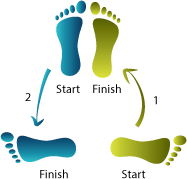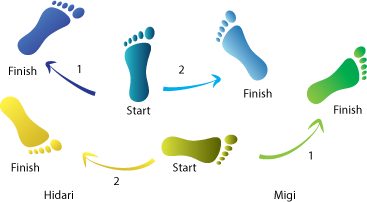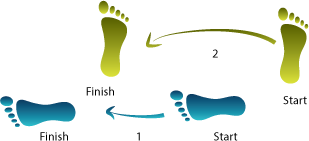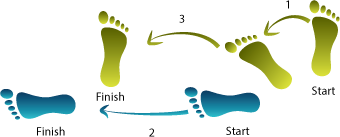Gorei (commands) | Kamae (stances) | Ashi sabaki (footwork) | Datotsu (strikes) | Kazoe kata (counting)
Glossary*
Arigato-gozaimashita
Thank you (used for end of training with partner or session)Onegaishimasu
Used as a request/thanks/hope for a good encounter (used prior to training with partner or session)Gokaku geiko
Free form match-up between naginata practitioners where targets strikes are attempted with correct technique; this is not about point-scoring, more about practicing techniques against a reactive partner.Ishu jiai
Free form competitive match between a kendo practitioner using a shinai and a naginata practitioner.Kakari geiko
Free form co-operative match-up where the more senior practitioner guides the more junior practitioner to correctly hit openly displayed target points at a quick pace.Shiai
Match
Gorei (commands)
Ato
To move backward or retreatHidari
LeftHajime
BeginMae
To move forward or advanceMigi
RightKiotsuke
AttentionKiritsu
Stand upKotai
Change positions / Rotate positionsMokuso
Call for meditation - sitting quietly in seiza with eyes closedNaore
Call to return to shizentaiRei
Formal bowSeiza
To sit in the formal kneeling position. Toes are touching at the back, knees slightly apart (1 fist width for men). Hands rest lightly on the thighs, pointing slightly inward with elbows in close to the body. Back is straight. This can also be performed in a kneeling up position when wearing bogu or if suffering from an injury that makes full kneeling difficult.Sensei ni
Face the senseiShomen ni
Face the head (shomen) of the dojoYame
Stop
>>Top of page | Gorei (commands) | Kamae (stances) | Ashi sabaki (footwork) | Datotsu (strikes) | Kazoe kata (counting)
Kamae (stances)
Click here to view a demonstration of some of the stances by the late, honorured Tanaka-sensei of the Northern California Naginata Federation.
Chudan no kamae
Middle guard position that is used to denote dis- or engagment. Naginata is held with kissaki in advance of the body, arms relaxed. Hands should be approximately shoulder width apart, with the distance to the ishizuki from the trailing hand being no more than the distance of the elbow. Trailing hand should be couched lightly where the upper leg meets the groin. Leading foot should point directly at opponent, trailing foot 90° perpendicular - feet should be approximately hip/shoulder width apart.Gedan no kamae
Low guard position where the habu is in advance of the body, kissaki downwards, and trailing hand is raised just above the shoulder. Naginata should be held to the chest.Hasso no kamae
Striking position where the body remains aligned in original kamae but with wrist of hand closest to ishizuki resting on the hipbone and hand closest to the kissaki raised next to and slightly outward from the ear.Jodan no kamae
High guard position where naginata is raised and reversed direction so that the ishizuki is pointing toward the opponents forehead.Mugamae
Described as null stance or guard. Naginata is locked into position underneath the arm with the kissaki pointing toward the ground.Waki gamae
Striking position or back guard where naginata resembles a reverse chudan no kamae with ishizuki facing opponent and slightly crossing centre of the body; forward hand should be lower or level with the back hand. Arms/elbows are more relaxed than chudan no kamae and there is a fist width between the hands on the naginata and the outside of the thigh.Shizentai
Neutral stance. Feet are together, back straight. Hand will rest on hip and lightly grip the naginata. Naginata is positioned with ishizuki resting on the floor in a small triangular arrangement with the big and little toe of the adjacent foot.
>>Top of page | Gorei (commands) | Kamae (stances) | Ashi sabaki (footwork) | Datotsu (strikes) | Kazoe kata (counting)
Ashi sabaki (footwork)
Ayumi ashi

Small paired walking steps crossing past fixed foot. Final step finishes in the style of an okuri ashi.Fumikae ashi

A 180° change of foot placement. Power comes from the swift movement of the hips rotating to the other side.Hiraki ashi

A step to the side (hidari or migi) with the foot closest to the direction raising first.Kumi ashi
A 180° twist of the upper body and hips with the feet remaining close to original position and legs crossing at the knees.Okuri ashi

Small step where foot in direction of motion is lifted first and power comes from pushing from the trailing foot.Tsugi ashi

A spring-like step where trailing foot comes quickly in to leading foot and pushes out in an okuri-ashi finish.
>>Top of page | Gorei (commands) | Kamae (stances) | Ashi sabaki (footwork) | Datotsu (strikes) | Kazoe kata (counting)
Datotsu, uchikata (attack/strikes)
Do uchi
A strike/cut across the stomach. The monouchi should land between the hips and ribs of the opponent in line with the spine.Furiage
An action where the naginata is raised directly above the head in preparation for a cut. Used for striking sokumen, kote and sune.Furikaeshi
An action where the naginata is rotated behind and above the head, the kissaki drawing a full circle as hands switch positions to complete the strike. Used for striking sokumen and sune.Kote uchi
A strike/cut across the wrist. The monouchi should land in the joint between hand and wrist.Mochikae
An action where the hands switch positions on the naginata.Shikake oji
Term to describe the forms for attack (shikake) and defense (oji). Also used to denote who will attack or defend during partner work.Shomen uchi
A strike/cut to the centre of the head. The monouchi should land front and centre of the head.Sokumen uchi
A strike/cut to either side of the head. The monouchi should land toward the front of the head, at an angle 10-15° from the centre line.Sune uchi
A strike/cut across the shin. The monouchi should land, angled, at a point midway between ankle and knee.Tsuki
A thrust to the throat (inko) or centre of body (do). The kissaki will thrust directly at the soft part of the target.Uchikaeshi
A set of repeated strikes and blocks. The pattern is: (furiage-ate) shomen, (hasso) sokumen, (hasso) sokumen, (hasso) sune, (hasso) sune, (furiage-ate) shomen.
>>Top of page | Gorei (commands) | Kamae (stances) | Ashi sabaki (footwork) | Datotsu (strikes) | Kazoe kata (counting)
Kazoe kata (counting)
| Counting | Kata | ||
| One | Ichi | First | Ipponme |
| Two | Ni | Second | Nihonme |
| Three | San | Third | Sanbonme |
| Four | Shi | Fourth | Yonhonme |
| Five | Go | Fifth | Gohonme |
| Six | Roku | Sixth | Roponme |
| Seven | Shichi | Seventh | Nanahonme |
| Eight | Hachi | Eigth | Hachihonme |
| Nine | Ku | - | - |
| Ten | Ju | - | - |
>>Top of page | Gorei (commands) | Kamae (stances) | Ashi sabaki (footwork) | Datotsu (strikes) | Kazoe kata (counting)
*Compiled and adapted from SCNF naginata glossary, Naginata Finland.